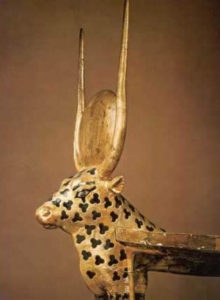
A depiction of Mehet-Weret carved onto a bed, found in the tomb of Tutankhamun.
Mehet-Weret was the deity of the sky in ancient Egyptian religion, whose mention dates back to the Pyramid Texts of Unas. These are a collection of ancient Egyptian religious texts that were created with the intention of helping the Pharaoh into the Egyptian underworld, also known as the Duat. These texts are estimated to date to the Old Kingdom which was between roughly 2686 – 2191 BCE. The Pyramid Texts were written in the Old Egyptian language and were found carved onto the walls and the sarcophagi of the pyramids that were created through the 5th and 6th dynasties.
The name Mehet-Weret translates as the ‘Great Flood’ due to her strong affiliation with the Nile river. However, she was known as the goddess of many things including water, creation, rebirth and the Milky Way. Mehet-Weret was primarily referenced in ancient Egyptian creation myths as being the mother of the solar god and personification of the sun, Ra. It was believed that she gave birth to Ra every morning, before leading him along the Nile and into the Duat every evening. The Book of the Dead says, “I behold Ra who was born yesterday from the thighs of the goddess Mehet-Weret”. This action gave the ancient Egyptians cause to believe that she was responsible for many different elements in life.
Firstly, she was known as the goddess in relation to the birth of the sun. This also meant that she was a deity who was associated with fertility and the creation of life, as she not only rebirthed Ra every morning but also by bringing the sun into the sky every day caused all crops to receive light. Her association with water and her name stems from the sun then causing the annual Nile flood, one of the most important events for the ancient Egyptians as without this no crops could grow. This also leads to her personification of the Milky Way, which the ancient Egyptians referred to as the Nile in the sky.
Her association with rebirth means she is featured in a number of spells in The Book of the Dead. This text dates to the New Kingdom (1550 – 1077BCE) but was believed to have been used up until around 50 BCE. Because of this it is possible to assume that Mehet-Weret had been active in ancient Egyptian religion for over 2500 years. The Book of the Dead is a collection of spells that were thought to assist a person through the Duat and into their afterlife. There is a partial copy of this collection in the Egyptian Mummies room in the British Museum in London which shows the intricate detail the Egyptians put into this text and therefore the esteem it held. In one particular spell Mehet-Weret is credited for the birth of Re, another name for Ra. She was believed to protect Re on his journey through life and into the Duat every day, so people would invoke her in their own journey through the underworld.
Mehet-Weret is also thought to have given birth to the Seven Wise Ones. They were thought to take the forms of seven hawks who along with the god Thoth, were responsible for the education and writing in ancient Egyptian society. The Seven Wise Ones are heavily associated with both Ra and the Nile, hence their connection the Mehet-Weret.
She is shown in art as having the head of a cow with the sun disk between her horns. She is also show to have either the body of a woman or that of a cow. This depiction shows her in relation to the goddess Hathor, who personified motherhood. This can also be seen in spell 186 of The Book of the Dead where both female deities are referred to as the Eye of Horus. A bed in the form of Mehet-Weret was found in Howard Carter’s 1922 discovery by the tomb of Tutankhamun, emphasising her connection with rebirth.
-Devon Allen
Junior Girl
Girl Museum Inc.
